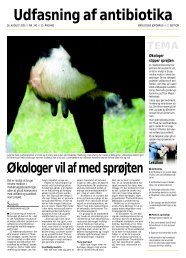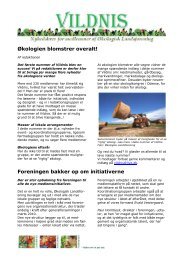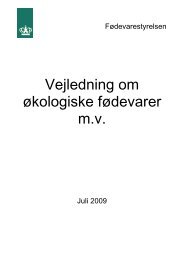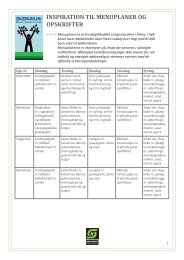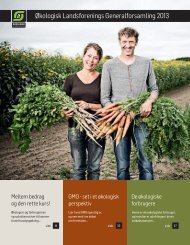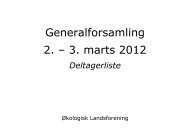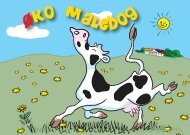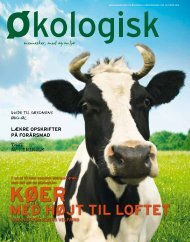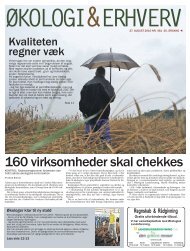Nitrogen distribution and potential nitrate leaching in a combined ...
Nitrogen distribution and potential nitrate leaching in a combined ...
Nitrogen distribution and potential nitrate leaching in a combined ...
You also want an ePaper? Increase the reach of your titles
YUMPU automatically turns print PDFs into web optimized ePapers that Google loves.
The stock<strong>in</strong>g densities varied because the sizes of the paddocks differed <strong>and</strong> because two<br />
animals were put down because of disease <strong>in</strong> the measur<strong>in</strong>g period March-May 2009. One pig<br />
was put down after a few days (paddock 2) <strong>and</strong> is not <strong>in</strong>cluded <strong>in</strong> the calculation of the<br />
stock<strong>in</strong>g density. In paddock 5 a pig was put down after 42 days. The average growth rate was<br />
885 g per pig per day <strong>and</strong> the pig was <strong>in</strong>cluded <strong>in</strong> the calculation for the 42 days it was alive.<br />
Dur<strong>in</strong>g the entire period, water <strong>and</strong> feed (see table 1 for feed-N <strong>in</strong>put) were offered to the pigs<br />
<strong>in</strong> the feed<strong>in</strong>g area (zone 1), <strong>and</strong> a hut was positioned with<strong>in</strong> 25 m of this po<strong>in</strong>t.<br />
2.3 Registration of defecation behavior<br />
The defecation behavior (def<strong>in</strong>ed as defecation behavior) of the pigs was monitored <strong>in</strong> spr<strong>in</strong>g<br />
<strong>and</strong> autumn 2009. The fattener pigs were observed two days every week from <strong>in</strong>sertion to<br />
slaughter<strong>in</strong>g (see app. 3 for registration table). In the <strong>in</strong>vestigation period March-May 2009<br />
behavioral observations of the pigs <strong>and</strong> the zone of occupation were registered from 08.00<br />
am-01.30 pm one day a week <strong>and</strong> from 02.00 pm to 07.30 pm another day <strong>in</strong> the same week.<br />
From September-November 2009 the observations were made from 08.00 am–03.30 pm at<br />
day one <strong>and</strong> from 04.00 pm-07.30 pm at day two <strong>in</strong> the same week. Each observation period<br />
per paddock lasted for 15 m<strong>in</strong>utes, with two-m<strong>in</strong>ute-<strong>in</strong>tervals of registration. This provided a<br />
snapshot of the defecation behavior of the pigs. Defecation <strong>and</strong> ur<strong>in</strong>ation were recorded for<br />
the whole two-m<strong>in</strong>ute period. In the autumn the registration dist<strong>in</strong>guished between the<br />
behavior ur<strong>in</strong>ation <strong>and</strong> defecation. The <strong>in</strong>itial paddock for registration of behavior was<br />
determ<strong>in</strong>ed by roll<strong>in</strong>g a die <strong>and</strong> the follow<strong>in</strong>g registrations were <strong>in</strong> a numerical order. Every<br />
session lasted for one <strong>and</strong> a half hour.<br />
2.4 Analytical methods<br />
2.4.1 Soil sampl<strong>in</strong>g<br />
In order to <strong>in</strong>vestigate the environmental effect of the defecation behavior of the pigs, soil<br />
samples were sampled for Nm<strong>in</strong> analysis. Soil samples were sampled <strong>in</strong> two depths (0-25cm<br />
<strong>and</strong> 25-75cm), with a 100cm Nm<strong>in</strong> soil auger model EHJ (see app. 4), at three occasions: (1) <strong>in</strong><br />
late August/early September 2009 before the <strong>in</strong>troduction of the fattener pigs; (2) <strong>in</strong><br />
November 2009 immediately after removal of the pigs; <strong>and</strong> (3) <strong>in</strong> early April 2010 when there<br />
was no longer frost. At occasion 1; 16 soil samples were taken <strong>in</strong> a grid <strong>and</strong> bulked at 16<br />
po<strong>in</strong>ts <strong>in</strong> each of the chosen zones. This was done to get an overall impression of the average<br />
soil concentration of Nm<strong>in</strong> <strong>in</strong> the zones. 16 soil samples <strong>in</strong> a zone provided 2 bulked soil<br />
11



